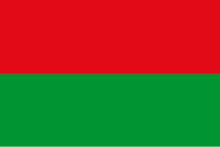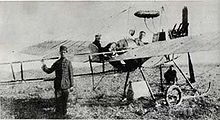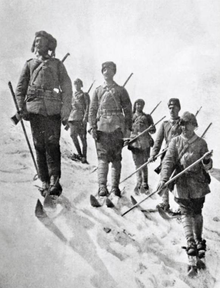Ottoman army
The Ottoman Army is the name given to the army of the Ottoman Empire from around 1299 to 1923. The Ottoman Empire owes its emergence and role as a decisive power in Asia Minor , the Middle East , the Balkans , North Africa and the Crimea to a large extent to the successes of the Ottoman army.
The emergence of the Ottoman Empire
The original armies of the Ottomans were pure equestrian armies , there was hardly any infantry and the artillery was not yet known. According to this tradition, the Sipahis , holders of military fiefs , played an important role in the Ottoman army for a long time. The Akıncı called scout troops played another important role in the army . Originally, the Ottoman military fought in the countryside with lances and arrows . In the initial phase, the operations of the Ottoman troops were small wars against Byzantine settlements. The Ottomans besieged the Byzantine cities and cut them off from supplies. Inegöl , Bilecik , Bursa and İznik came under Ottoman rule by 1331 .
Due to the ever increasing size of the empire, the troops were divided into troops of the sultan (" troops of the gate ") and border guards who were subordinate to the Walis , the provincial governors. The Kapikuli as the sultan's guard belonged to the troops of the gate, the Serratkuli to the border guards. Due to the feudal system of the Sipahis, campaigns were usually started on Hizir Day (May 6th) and the troops usually returned on Kasim Day (beginning of November), which meant that the warfare was usually limited to six months.
As an infantry component of the army, the Janissary Corps was created from around 1330 , which was directly subordinate to the Sultan. From 1438 the janissaries were systematically recruited through the so-called boy reading , in which boys mainly from the Balkans, especially Serbia and Bosnia , were selected and brought to the Ottoman Empire for education and training. As a standing force with fixed pay and sometimes with pension commitments, regardless of whether it was peacetime or war, the Janissaries - unlike the feudal army, which only cost money in war - became a heavy financial burden for the empire.
From 1420 the Ottomans created an artillery, the Topçu , with the help of Italian, Hungarian and German cannon founders , which were also subordinate to the Sultan.
In its campaigns of conquest, the Ottoman army extended the Ottoman Empire to large parts of south-eastern Europe until the end of the 15th century . The Ottomans destroyed the Byzantine Empire and until the last third of the 17th century subjugated the territories of today's states Greece , North Macedonia , Albania , Bulgaria , Serbia, Bosnia and Herzegovina , Romania , southern Ukraine ( Podolia , Jedisan , Crimea ), to which parts of the Kingdom of Hungary (Central Hungary, Transylvania ) and Moldova followed. At the same time, large parts of Asia Minor were annexed to the Ottoman Empire. In Western Europe, the fall of Constantinople (1453) was received with great horror.
The Ottoman strategy was always offensive, but the tactics in battle were defensive.
The Serb Constantine from Ostroviza writes in his memoirs of a Janissary (15th century):
- The formation of the army of the Sultan's court takes place as follows: The courtly cavalry has its place next to the Sultan, in front of him the Janissaries, behind him the camels. Ditches and walls are being built around them on all sides. (...) a wall into which skewers are hammered close together. Then piece beds are set up for the guns so that you can shoot from the cannons.
The janissaries stood in the sultan's hill , flanked by the artillery ( Topçu ) and the Kapikuli cavalry. Before that, the Serratkuli infantry (the troops from Rumelia and Anatolia) and the Sipahis . In advance, the Akıncı swarmed out as scouts and troublemakers. The heavy Christian cavalry usually broke through these first lines relatively quickly and stormed to the sultan's hill. There the advance of the tired riders was stopped abruptly and they were either destroyed or routed by the concentrated deployment of the elite troops and artillery.
The occidental art of war persisted too long in the belief in the decisive battlefield use of heavy armored cavalry as in the high Middle Ages. The Christian military leaders also had poor or no enlightenment at their disposal. The further development of Turkish tactics (especially the artillery) remained hidden from them for a long time, so that these mistakes kept recurring on the battlefield.
The Ottomans before Vienna
At the beginning of the 16th century, another massive expansion of the Ottoman Empire followed through further conquest. The Ottoman army at that time was a modern army.
The Ottoman army was reformed under Selim I. He had the artillery modernized, contained the power of the Janissaries and began building a fleet. Under him the Ottoman army fought against Persia, conquered Syria , Egypt and the holy cities of Mecca and Medina . Under Sultan Suleyman I the Magnificent , who had ruled since 1520 , the Kingdom of Hungary became the target of Ottoman expansion policy. The successful siege of Belgrade led to a 150-year heyday of the city of Belgrade from 1521 . In 1522 the Ottoman army landed on Rhodes and took the fortress in December 1522. In 1526 an army of about 60,000 to 70,000 men marched north, to which 10,000 Sipahis and 12,000 Janissaries belonged. In August 1526, she defeated the Hungarian army in the Battle of Mohács . From September 27 to October 14, 1529, the first Turkish siege of Vienna took place , whereby the defenders of the city were able to assert themselves against the besiegers due to the adverse weather. With three campaigns against the Safavids , the Ottoman army finally succeeded in conquering east Asia Minor . There were annexations on other fronts as well: 1534 Mesopotamia with Baghdad , 1534 Azerbaijan, 1540 parts of Dalmatia , 1547 large parts of Yemen . In 1566, the Ottoman troops started another campaign in Hungary. However, Suleyman I died during the siege of Szigetvár . The death of the sultan, the total losses during the siege of around 20,000 men and the onset of winter caused the Ottoman army to retreat to Constantinople.
In the period that followed, the Janissaries greatly expanded their influence over the sultans, while their reputation as an elite military unit deteriorated. From the second half of the 17th century the fighting strength of the Ottoman army waned. Vienna was besieged again in 1683 at the beginning of the Great Turkish War . The failure of this siege led to the expulsion of the Ottomans from the territory of the Kingdom of Hungary by the imperial army in the following major offensive .

The sick man on the Bosporus

During and after the Russo-Turkish War 1768–1774 , the Ottoman Empire finally had to recognize that it had lost its world power position . In the 19th century, the formerly powerful Ottoman Empire, now called the Sick Man on the Bosporus , was weakened by uprisings in the occupied territories and increasingly became the plaything of the European powers.
Realizing that traditional Ottoman forces were no match for modern European armies, Selim III created. (Sultan since 1789) with the Nizâm-ı Cedîd /نظام جديد / 'New Order' units based on the European model. Selim also hired foreign officers as trainers. His planned gradual transfer of the Janissaries to the new corps, however, led to uprisings that culminated in his dismissal in May 1807. Mustafa IV supported the Janissaries in their revolt against the reform attempts of his cousin Selim III. and was then appointed by them as sultan. Mahmud II decided around 1820 to abolish the Janissaries, which had become too powerful. When they noticed that the Sultan was forming a new army, they rebelled on the 14th and 15th. June 1826. The rebellion was bloodily suppressed using artillery organized on the European model and the corps was disbanded. This incident was henceforth described as a "charitable event". In 1831 the Sultan also abolished the Sipahi.
Muhammad Ali Pasha asserts himself as governor in the Ottoman province of Egypt . Under his rule, the Egyptian army was modernized by the French Colonel Sève (Süleyman Pascha). Mainly by soldiers of this newly formed army, the Wahhabis in Arabia were defeated in the Ottoman-Saudi War (1811-1818) . 1820–1823, the Egyptians pushed further and further south along the Nile in order to conquer Sudan . During the uprising in Greece (1822-1827) Sultan Mahmut II was forced to call Muhammad Ali for his support after three unsuccessful campaigns. The disciplined Egyptian army , supported by a well-organized fleet, quickly achieved what the Ottoman army had failed. After the intervention of a British-French fleet in the Battle of Navarino (October 1827), the Ottoman Empire had to give Greece independence in 1830.
In 1831 the Egyptian vassal's invasion of Palestine and Syria began , with the Egyptian army advancing through Anatolia to Istanbul after several victories over the Ottoman army . Although the Egyptians had to withdraw after the peace of Kütajeh , they were able to maintain Syria and Cilicia .
In the 1830s, Prussian officers (e.g. von Moltke ) carried out extensive reforms in the Ottoman army. In the mid-19th century, this consisted of the regular army (Nisam), the troops of the vassal states, the reserve ( Redif ) and the irregular troops. The regular army consisted of six army corps and were each commanded by a field marshal (Muschir). The total strength of the regular army was 136,000 men.
The Ottoman army fought in the Crimean War (1853–56) much more successfully than in the Russo-Turkish War of 1828–1829 . The Ottoman general Omar Pascha defeated the Russians on November 4, 1853 near Oltenitza . He was later able to end the siege of Silistra and entered Bucharest on August 22, 1854 .
In the Russo-Turkish War of 1877 , Russia was able to penetrate to the walls of Constantinople. To prevent an occupation of his capital, the Sultan was forced in March 1878 to sign the peace of San Stefano after the armistice of Edirne .
The military and foreign policy actions of Russia called the other great powers on the scene; The Berlin Congress took place in mid-1878 .
Around 1904 the mobilization strength of the army was 1,795,350 men, the active strength 230,408 men. The army was divided into seven army corps and the independent commandos of Tripoli and Hejaz .
In June 1909 the air force of the Ottoman Empire was founded; it was one of the first combat air troops in the world. Shortly afterwards, a period of conflict and war began for the armed forces of the Ottoman Empire: two Balkan Wars (1912/13 summer 1913), World War I , and the Turkish War of Liberation (May 1919 to October 1923) . The Turkish Air Force achieved its first successes in Yemen and the Caucasus and in the Turkish Liberation War (led by Ataturk ) against the victorious powers of the First World War.
First World War
The neglected and disorganized state of the Ottoman army led to the appointment of a German military mission with extensive powers under Liman von Sanders in 1913 . But this led to a tightening of relations with the powers of the Entente . After the alliance between Turkey and the German Reich on November 2, 1914, Great Britain , France and Russia declared war on Turkey. From February 19, 1915 to January 9, 1916, the Ottoman Army was able to repel the landing of the Allies in the Battle of the Dardanelles with German military assistance . After this success the triumphant advance of the Ottoman armies continued. The Ottoman army was supported by the German Levante Corps and Austrian troops in both Mesopotamia and Palestine. In Mesopotamia , an Anglo-Indian division was forced to surrender to the siege of Kut on April 29, 1916 . From the positions already occupied on the Sinai Peninsula , the troops of the Ottoman Empire tried to conquer the Suez Canal . In June 1916, the British repulsed this advance and began a counter-offensive on the Sinai Peninsula.
Despite massive superiority, it took the British three years to conquer Baghdad , Jerusalem and Damascus .
On the Caucasus front , the Russian Empire was able to achieve dominance in this theater of war in the early years of the war. The Ottoman Empire suffered a devastating defeat at the turn of the year 1914/1915 in the Battle of Sarıkamış . In the subsequent Russian counter-offensive, the Ottomans suffered great losses of territory in Eastern Anatolia. After Russia's initial successes, after February 23, 1917, the Russian advance came to a standstill due to the effects of the February Revolution . The Russian Caucasus Army dissolved in the wake of the Russian revolutionary turmoil.
After the defeat and surrender, the Porte signed the Mudros armistice with the victorious powers on October 30, 1918 . On the basis of this agreement almost all areas of Turkey were occupied by Great Britain, France, Italy and Greece. This led to the Turkish Liberation War , which could not be crushed by a specially set up department of the Ottoman Army, the Kuva-yi İnzibatiye , and ultimately led to the abolition of the Sultanate in November 1922. The Ottoman army was disbanded. Mustafa Kemal Pascha, who later became Ataturk, also re-founded the Turkish armed forces after the republic .
Significant people

|
Cigalazade Yusuf Sinan Pasha (1545-1605)
Ottoman civil servant, general and admiral. |
|
Kara Mustafa Pascha (around 1630–1683)
Grand Vizier of the Ottoman Empire and Commander-in-Chief at the Second Siege of Vienna , during the Great Turkish War 1683–1699 , under the reign of Sultan Mehmet IV. |
|
Khair ad-Din Barbarossa (1478-1546)
Ottoman corsair in the Mediterranean, ruler of Algiers and Kaptan-ı Derya of the Ottoman Empire. |
|
Omar Pasha (1806-1871)
Ottoman general and renegade of Serbian origin. He fought in the Crimean War. |
|
Hussein Pascha (1819–1876)
Turkish general and statesman. Hussein was Minister of War and carried out a reorganization of the army of the Ottoman Empire. |
|
Nuri Pascha Osman (1832-1900)
General of the Ottoman Army in the Russo-Turkish War (1877–1878) . |
|
Otto Liman von Sanders (1855–1929)
Ottoman Marshal and Prussian General in World War I who led the Ottoman Army in the Battle of Gallipoli . |
|
Colmar von der Goltz (1843–1916)
Prussian field marshal who reorganized the Ottoman army. |
|
Ismail Enver (1881-1922)
Politician, general and minister of war of the Ottoman Empire and young Turkish nationalist. |
|
Mustafa Kemal Ataturk (1881–1938)
General and first President of the Republic of Turkey, which emerged from the Ottoman Empire after the First World War . |
Museum reception
The Turkish wars and the Ottoman army of the 16th, 17th and 18th centuries take up a large part of the exhibition in the permanent exhibition of the Vienna Army History Museum . Numerous objects are open to the public, including several horse tails and the infamous Sipahi's reflex arcs . Special pieces are also a Turkish chain mail from the possession of at Mogersdorf winning imperial generals Raimondo Montecuccoli , a silver Turkish calendar watch, a 1683 before Vienna captured Turkish standard ( Osmanl-i Sancagi ) as well as the seal of the Turkish Sultan Mustafa II. Obtained by Prince Eugene of Savoy was captured in the Battle of Zenta in 1697.
See also
literature
- Gábor Ágoston: Firearms for the Sultan. Warfare and arms industry in the Ottoman Empire. Translated from English by Ralf C. Müller. 1st edition. Eudora-Verlag, Leipzig 2010, ISBN 978-3-938533-10-9 .
- Edward J. Erickson: Defeat in Detail. The Ottoman Army in the Balkans, 1912–1913. Greenwood Publishing Group, 2003, ISBN 0-275-97888-5 .
- Wolfgang Gust: History of the Ottoman Empire. Augsburg 1995, ISBN 3-8289-0562-5 .
- Nicolae Jorga: History of the Ottoman Empire. Gotha 1913, ISBN 3-8218-5026-4 .
- Rhoads Murphey: Ottoman Warfare, 1500–1700 (= Warfare and History). UCL Press Limited, London 1999, ISBN 0-203-01597-5 .
- Mark L. Stein: Guarding the Frontier. Ottoman Border Forts and Garrisons in Europe (= Library of Ottoman Studies. 11). IB Tauris, New York 2007, ISBN 978-1-84511-301-8 .
- David Woodward: Armies of the World 1854-1914. London 1978, ISBN 0-283-98243-8 .
Individual evidence
- ^ David Woodward: Armies of the World 1854-1914. London 1978, ISBN 0-283-98243-8 , pp. 79 ff.
- ^ Manfried Rauchsteiner , Manfred Litscher (Ed.): The Army History Museum in Vienna. Graz / Vienna 2000, ISBN 3-222-12834-0 , p. 16.
- ↑ Johann Christoph Allmayer-Beck : The Army History Museum Vienna. Room I - From the beginnings of the standing army to the end of the 17th century. Salzburg 1981, ISBN 3-7023-0113-5 , p. 30.














